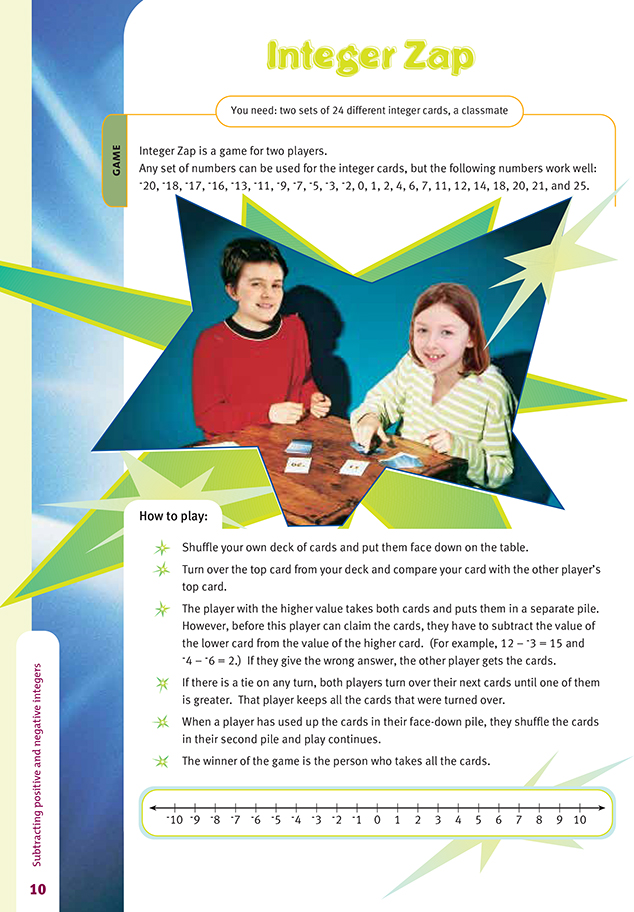This is a level 4 number link activity from the Figure It Out series. It relates to Stage 7 of the Number Framework.
A PDF of the student activity is included.
Click on the image to enlarge it. Click again to close. Download PDF (242 KB)
add and subtract integers
Two sets of 24 different integer cards
FIO, Link, Number, Book Four, Integer Zap, page 10
A classmate
Game
Do not use this game to introduce your students to the subtraction of negative numbers, which is quite a difficult concept to grasp. The game has more value as a reinforcement activity.
Before they begin this game, the students may need to review and investigate some situations involving the subtraction of negative numbers. Subtracting an integer is the same as adding its opposite.
For example:
Therefore, instead of subtracting a negative number, we can add the corresponding positive number.
Small groups may explore a representative set of integer subtraction problems.
For example (answers are given in brackets):
Another way the students can subtract integers is to apply an additive approach using inverse operations. For example, in the equation -3 – 6 =, the -3 is the sum and 6 is the addend. So, what number when added to 6 will give a sum of -3, or 6 + = -3? As 6 would need a movement of -9 to reach the position -3, the answer in the original equation must be -9.
While the equations listed on the previous page cannot all be modelled directly using actual materials, it is possible to explore the problems using counters and compensation strategies. For example, using -2 – -4 = , ask: “What does this equation say?” (Begin with negative 2 and subtract negative 4.) “How can we do this?” Give the students two sets of coloured counters, for example, red and black. Invite discussion, perhaps using bank balances. Red could represent negative numbers, and black could represent positive numbers.
Ask: “How can you take away four negative counters when you have only two negative counters?”
Have the students add on a negative red counter and a positive black counter, which will keep the relationship equivalent to the original amount. They now have three red and one black.
“Can we now subtract four negative counters?” The answer is still no.
“Add another negative red counter and a positive black counter. You now have four red counters and two black counters. Take away the four negative red counters. What answer remains?” (Two positive black counters.) This is one way of modelling -2 – -4 = 2.
The students could explore the equations above, using strategies such as reverse additive, number line, or models with calculator checking. To play the game successfully, they need to become proficient at knowing what to do when thinking about:
positive – positive
positive – negative
negative – positive
negative – negative
A possible number line could be:
The students could use it by following these steps:
• Circle the starting number.
• Add on a positive number by moving to the right (for example, 1 + 2 = 3). Subtract a positive number by moving to the left (for example, 1 – 2 = -1).
• Add on a negative number by moving to the left (for example, 1 + -2 = -1). Subtract a negative number by moving to the right (for example, 1 – -2 = 3).
The process of subtracting negative integers may stretch some students, but the more they play the game,the better and more proficient they will become at mental subtraction with integers.
Check that the students are selecting the correct higher value card, especially when both cards are negative numbers. For example, -5 is a higher value than -9. While you should encourage mental subtraction, some students may need the support of being able to jot down their workings on scrap paper, use a number line, or even use a calculator until they feel able to do the subtraction mentally.
Answers to Activity
Game
A game using integers



